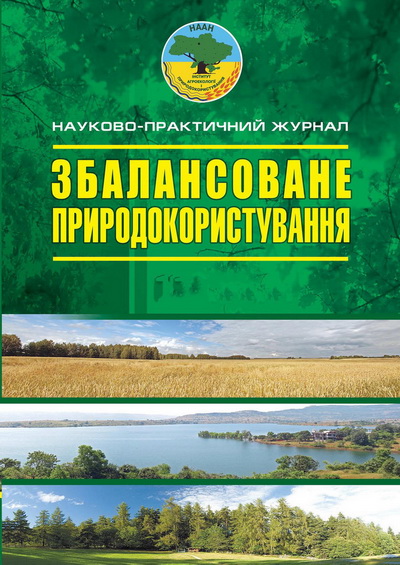FEATURES OF ENVIRONMENTAL EVALUATION OF LANDS
DOI:
https://doi.org/10.33730/2310-4678.1.2019.170598Keywords:
peculiarity, ecological assessment, land resources, agro-ecological potential, solar energy, phytoviruses, environmental safetyAbstract
A number of features of the ecological assessment of lands were examined, the scientific and methodological foundations of the agro-ecological potential of agricultural land were substantiated, and the influence of solar energy on vegetation was noted. It has been established that one of the aspects of agroecological studies that directly form the system of ecological assessment of lands is the modeling of the future parameters of the ecologically safe use of natural resources, primarily land in agriculture. It was determined that the criterion for environmental assessment should be the yield of individual crops and the overall productivity of crops. It is proved that the probable objectivity of environmental assessment can be achieved when crop production is determined in units equivalent to the absorption of solar energy and nutrients by plants. Such an assessment should be based on the translation of the cadastral yield into energy units using constant coefficients for all agro-industrial groups. The theoretical and methodological foundations of the formation of ecologically unfriendly land use, mainly in agriculture, are considered. It has been proved that indirect influence on the soil and the plant also provides the environment for the development of viruses, can lead to a change in the infectivity of already known pathogens and, possibly, the emergence of new, more harmful to existing strains of viruses.
References
Akulov, P.G. (1991). Vosproizvodstvo plodorodiya i produktivnost’ chernozemov [Reproduction of fertility and productivity of black soil]. Moscow: Kolos. 116. (in Russ.)
Val’kov, V.F. (1986). Pochvennaja jekologija sel’skohozjajstvennyh rastenij [Soil ecology of agricultural plants]. Moscow: Agropromizdat. 206. (In Russ.)
Dobriak, D.S., Kanash, O.P., Bambindra, D.I. & Rozumnyj, I.A. (2009). Klasyfikatsiia sil’s’kohospodars’kykh zemel’ iak naukova peredumova ikh ekolohobezpechnoho vykorystannia [Classification of agricultural land as a scientific prerequisite for their environmentally friendly use]. Kyiv: Urozhaj. 464. (In Ukr.)
Kovda, V.A. (1973). Osnovy uchenija o pochvah. Kniga 1 [Fundamentals of soil theory. Book 1]. Moscow: Nauka. 430. (In Russ.)
Kovda, V.A. (1973). Osnovy uchenija o pochvah. Kniga 2 [Fundamentals of soil theory. Book 2]. Moscow: Nauka. 380. (In Russ.)
Larher, V. (1978). Jekologija rastenij [Plant ecology]. Moscow: Mir. 420. (In Russ.)
Mel’nyk, P.P. (2016). Ekoloho-ekonomini osnovy upravlinnya pryrodokorystuvannyam v ahroekosystemakh [Ecological-economical bases of environmental management in agroecosystems]. Kyiv: DIA, 326.
(In Ukr.)
Polischuk, V.P., Budzanovsky, I.G., Ryzhuk, S.M., Pattika, V.P. & Boyko, A.L. (2001). Monitorynh virusnykh infektsiy roslyn v biotsenozakh Ukrayiny [Monitoring of virus infections of plants in biocenoses of Ukraine]. Polischuk V.P. (Ed.). Kyiv: Phytocenter, 220. (In Ukr.)
Medvedev, V.V., Buka, A.YA. & Rozumnyy, I.A. i dr. (1991). Pochvenno-ekologicheskiye usloviya vozdelyvaniya
sel’skokhozyaystvennykh kul’tur [Soil-ecological conditions for the cultivation of agricultural crops]. Kiev: Institute of Land Management. 74. (In Ukr.)
Svetlitskiy, N.I. (1982). Yekologicheskaya bioyenergetika rasteniy i sel’s’kokhozyaystvennoye proizvodstvo [Ecological bioenergetics of plants and agricultural production]. Moscow: Nauka. 208. (in Russ.)
Uatt, K. (1978). Jekologija i upravlenie prirodnymi resursami [Ecology and natural resource management]. Moscow: Nauka, 280. (In Russ.)
Furdychko, O.I. (2014). Ekolohichni osnovy rozvytku ahrosfery v konteksti yevropeys’koyi intehratsiyi Ukrayiny [Ecological bases of agrosphere development in the context of European integration of Ukraine]. Kyiv: DIA. 432. (In Ukr.)
Downloads
Issue
Section
License
- The authors reserve the right to authorship their work and pass the journal the right to publish this work under a Creative Commons Attribution License license, which allows other persons to freely distribute the published work with the obligatory The authors of the original work and the first publication of this magazine.
- The authors have the right to make independent additional agreements on the nonexclusive dissemination of the work in the form in which it was published by this magazine (for example, to post work in the company's electronic storage or to publish as a monograph) , subject to the first publication of the link to this journal.
- Journal policy allows and encourages the placement of authors on the Internet (for example, in the repositories of institutions or on personal websites) manuscript work as to the presentation of this manuscript to the editorial board and during its editorial processing, as it contributes to The productive scientific discussion and positively affects the efficiency and dynamics of citation published work (see The Effect of Open Access).


